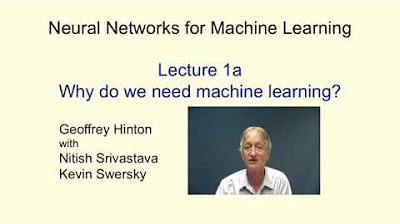But what is a neural network? | Chapter 1, Deep learning
Summary
TLDR这段视频脚本深入探讨了神经网络的基本概念和工作原理,特别是它们如何识别手写数字。视频从一个低分辨率的数字“3”图像开始,展示了人类大脑如何轻松识别不同的数字,即使它们的像素值差异很大。接着,脚本介绍了构建一个能够处理28x28像素网格并输出0到10之间数字的程序的挑战,这引出了机器学习和神经网络的重要性。视频的目标是帮助观众理解神经网络的结构,并可视化其数学原理,而不仅仅是作为一个流行词汇。通过构建一个简单的神经网络模型,脚本解释了网络是如何通过多个层次的神经元(称为激活)来识别手写数字的。每个神经元代表一个数字,并且网络通过调整这些神经元之间的连接权重和偏置来“学习”。视频还讨论了网络中的隐藏层可能如何识别数字的子组件,如边缘和环。最后,脚本提到了sigmoid函数和ReLU(修正线性单元)在神经网络激活中的作用,并预告了下一期视频将深入探讨网络如何通过数据学习适当的权重和偏置。
Takeaways
- 🧠 大脑能够轻松识别低分辨率图像中的数字,这展示了人类视觉识别的惊人能力。
- 📈 编写一个能够识别28x28像素图像中数字的程序是一项艰巨的任务,这突显了机器学习和神经网络的重要性。
- 🌟 神经网络的结构和学习过程将通过视频以数学的角度进行介绍,以帮助观众理解。
- 🔍 神经网络的设计灵感来源于人脑,特别是神经元如何链接在一起。
- 🔢 输入层的神经元数量与像素点对应,每个神经元代表一个像素的灰度值。
- 📊 输出层有10个神经元,每个神经元代表一个数字,其激活值表示系统认为图像与特定数字的匹配程度。
- 🤔 隐藏层的作用尚不清楚,但它们在识别数字的过程中起到关键作用。
- 🔗 每一层的激活值决定了下一层的激活值,这是神经网络作为信息处理机制的核心。
- 📉 通过训练,神经网络能够学习到如何将像素组合成边缘、模式或数字。
- 🎯 权重和偏置是神经网络中的关键参数,它们决定了网络如何响应输入图像。
- 🤝 神经网络的学习过程涉及调整成千上万的权重和偏置,以找到解决问题的最佳设置。
- 📚 线性代数是理解神经网络的关键,特别是矩阵和向量乘法的概念。
Q & A
为什么人脑能够轻松识别不同分辨率和风格中的数字3?
-人脑的视觉皮层非常发达,它能够识别和解析不同的视觉模式,即使像素值和激活的光敏细胞在不同的图像中差异很大,大脑仍然能够将它们识别为相同的数字3。
编写一个能够识别28x28像素网格中手写数字的程序为何变得非常困难?
-因为需要设计一个能够理解像素模式并将其转换为0到10之间数字的复杂算法,这涉及到大量的参数调整和深度学习知识。
神经网络的结构是如何启发于人脑的?
-神经网络的结构模仿了人脑中的神经元网络,其中神经元是持有0到1之间数值的单元,通过层级结构处理信息,类似于大脑中神经元的激活模式。
神经网络的第一层包含多少个神经元,它们代表什么?
-神经网络的第一层包含784个神经元,每个神经元代表输入图像中一个28x28像素点的灰度值。
输出层有10个神经元,它们代表什么含义?
-输出层的10个神经元每个代表一个数字,从0到9。它们的激活值表示系统认为给定图像与某个数字的对应程度。
隐藏层在神经网络中扮演什么角色?
-隐藏层是神经网络中的中间层,它们处理输入层的信息,并为输出层提供更高级的特征表示,帮助网络识别更复杂的模式。
如何通过数学方式表示神经网络中一层激活值对下一层的影响?
-通过权重矩阵和激活向量的矩阵乘法,再加上偏置向量,然后通过sigmoid函数将结果压缩到0和1之间。
为什么现代神经网络较少使用sigmoid函数?
-因为sigmoid函数在训练时存在一些困难,而现代网络更倾向于使用ReLU(修正线性单元)函数,它更容易训练,并且对于深度神经网络表现更好。
网络中的权重和偏置是如何决定神经元激活的?
-权重决定了神经元如何响应前一层的激活模式,而偏置则决定了神经元开始显著激活的阈值。通过调整权重和偏置,可以训练网络识别特定的模式。
为什么说神经网络的训练过程是寻找合适的权重和偏置设置?
-因为神经网络的性能依赖于这些参数,通过训练数据调整这些参数,可以使网络更好地识别和预测目标,解决特定的问题。
为什么理解矩阵和矩阵向量乘法对于学习机器学习很重要?
-矩阵和矩阵向量乘法是神经网络中信息传递和变换的基础,它们在表示和计算神经网络的层间转换时非常关键,且许多机器学习库对矩阵运算进行了优化。
如何将神经网络中的复杂数学表达式简化以便于理解和编程实现?
-通过将权重矩阵和偏置向量表示为符号,并利用矩阵向量乘法和sigmoid函数的组合,可以非常紧凑和高效地表达神经网络的激活转换过程。
Outlines

此内容仅限付费用户访问。 请升级后访问。
立即升级Mindmap

此内容仅限付费用户访问。 请升级后访问。
立即升级Keywords

此内容仅限付费用户访问。 请升级后访问。
立即升级Highlights

此内容仅限付费用户访问。 请升级后访问。
立即升级Transcripts

此内容仅限付费用户访问。 请升级后访问。
立即升级浏览更多相关视频

Computer Vision: Crash Course Computer Science #35

Geoffrey Hinton: The Foundations of Deep Learning

WE MUST ADD STRUCTURE TO DEEP LEARNING BECAUSE...

Lecture 1.1 — Why do we need machine learning — [ Deep Learning | Geoffrey Hinton | UofT ]

Ilya Sutskever | The future of AGI will be like what you see in the movies

Is consciousness an illusion? 5 experts explain

The Godfather in Conversation: Why Geoffrey Hinton is worried about the future of AI
5.0 / 5 (0 votes)